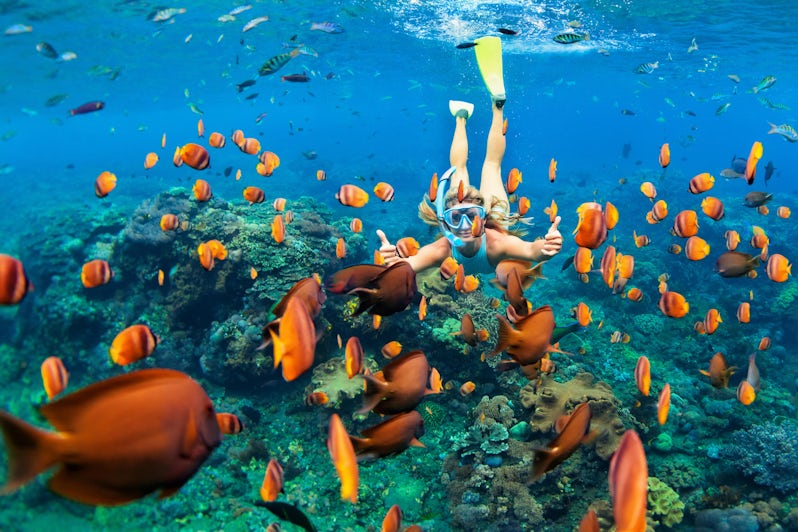
Best Diving and Snorkeling in the Caribbean for Cruisers


If you're cruising the Caribbean and you're also a snorkeler or diver, you're in luck -- the region boasts some of the most diverse underwater marine environments in the world. Ports of call like Georgetown, Grand Cayman, Bonaire and Cozumel are minutes from some of the best sites for everyone from the novice snorkeler to the seasoned diver.
Picking between an Eastern or Western Caribbean cruise is no small feat, especially if you’re planning to go snorkeling or diving. To help you decide, we’ve put together a list of the reefs, beaches and shipwrecks with the best diving and snorkeling in Caribbean waters.
But first, a tip: If you plan on diving more than once or twice on your trip, it's worthwhile to bring your own gear (if you have it); even casual snorkelers should consider bringing their own mask and snorkel for both fit and hygiene purposes.
Best Diving and Snorkeling in the Western Caribbean
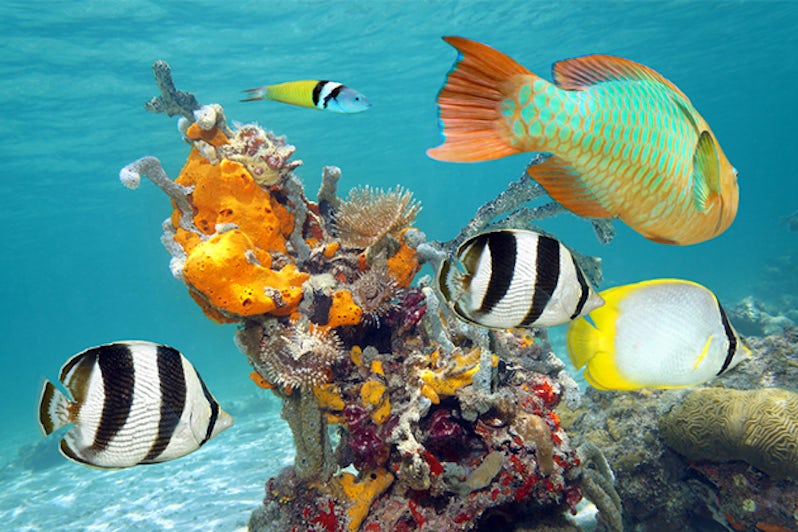
From Mexico to Belize, the Western Caribbean is an excellent pick for those looking to go on a shorter, budget-friendly cruise. Itineraries usually visit fewer island ports and are particularly popular with those interested in exploring Mayan culture. Plus, these cruises offer some of the best snorkeling in the Caribbean, as well as top-notch spots for diving.
1. Cancun and Isla Mujeres, Mexico: Underwater Museum and Gigantic Whale Sharks
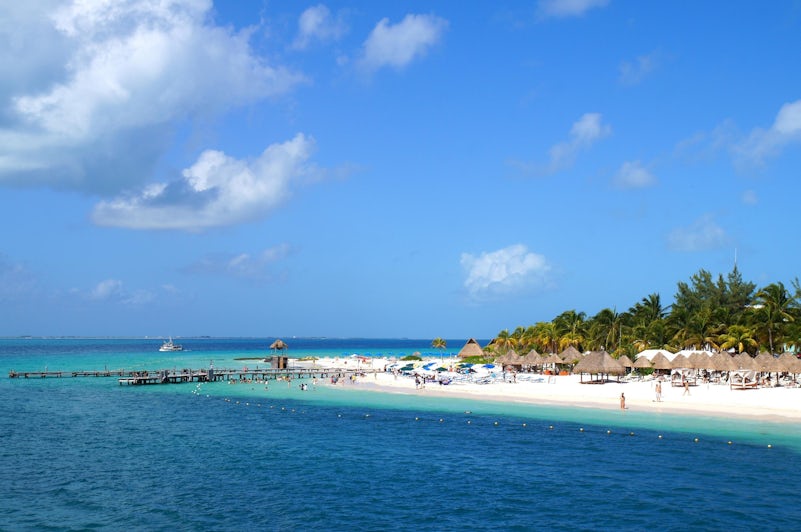
In addition to the second longest coral reef in the world (which extends into Belize), Cancun offers a unique underwater attraction, the Museo Subacuatico de Arte (MUSA) or underwater museum. Designed by artist Jason deCaires Taylor, MUSA offers divers and snorkelers over 500 underwater sculptures scattered over a wide area.
Your cruise line will most likely offer snorkeling and diving shore excursions, but you can also find them through local dive shops and directly with the MUSA, which also offers glass-bottom boat tours.
If marine life encounters are what you’re after, head to Isla Mujeres instead. In the last few years, hundreds of gigantic whale sharks (some measuring up to 40 feet long), all feeding on a smorgasbord of fish eggs in the water, have begun frequenting the waters around this tiny island. It's a snorkel-only experience, but divers won't miss their regulators for a second.
2. Key West, Florida: Shipwrecks Galore
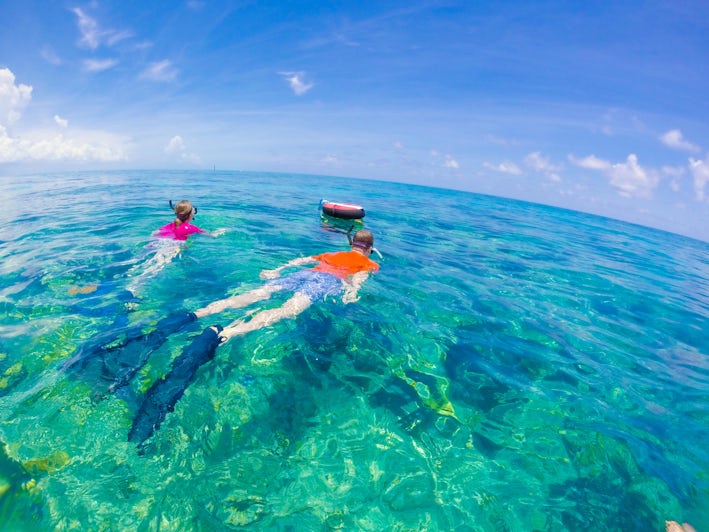
The Florida Keys National Marine Sanctuary spans 120 miles from Key Largo in the north to Key West in the southwest, and protects nearly 3,000 nautical miles of coastline and waters, home to the third largest barrier reef system in the world. Divers and snorkelers are spoiled for choice, with shipwrecks, coral reefs, mangroves and seagrass habitats all competing for their attention.
Divers will want to check out the USS Vandenberg, an ex-military missile-tracking ship that went down seven miles south of Key West in May 2009. Sitting in 145 feet of water, the top of the superstructure is at a more diveable 45 feet. Owing to depths and the likelihood of currents, the Vandenberg is better suited to advanced divers.
On the wrecks, you can expect to see jacks, groupers and lobster. Snorkel excursions will yield much of the same, plus small tropicals.
3. Cozumel, Mexico: Palancar Reef, Tormentos Reef, Santa Rosa Wall, and Chankanaab Marine Park

A teardrop-shaped island a little over 10 miles from Playa del Carmen, Cozumel's been known for years as offering some of the best diving in the Caribbean. Famous sites like Palancar Reef, Tormentos Reef and Santa Rosa Wall run the length of the western side of the island.
Cozumel's known for strong currents; boats drop divers in the water, and they drift effortlessly over reefs at depths anywhere from 40 to 100 feet. At the end of the dive, divers surface where they are and the boat comes to them.
Good snorkel trips leave from the Money Bar dock (formerly known as Dzul Ha). Many cruise ship excursions feature snorkeling here, but you can book from the bar directly too. Snorkeling here is suitable for novices.
Chankanaab Marine Park is another great snorkel spot -- bypass the captive dolphin experiences and check out the underwater statues of Christ and Chaac Mool, the Aztec rain god, as well as thick schools of Bermuda chubs and jacks. Entry on the iron-shore reef is easy via steps from the beach.
4. Ambergris Caye, Belize: Belize Barrier Reef, Coral Gardens and Shark Ray Alley
Located inside the Belize Barrier Reef, Ambergris Caye is one of the top snorkeling spots in the country. It may not be as famous as the Great Blue Hole, but it won’t disappoint either. While there are diving excursions available, the caye is best for snorkeling.
The trip to Ambergris Caye from the cruise terminal requires either a cruise line-operated excursion, a 15-minute flight from Belize City to San Pedro, or a ferry ride that can take anywhere between 45 and 75 minutes each way. The experience, though, is worth the hassle. The reefs are packed with lobsters, conch, rays, and all kinds of fish; the waters are shallow and generally tranquil.
If you want to stay closer to San Pedro, Coral Gardens has shallow waters and colorful corals. The best spots, however, are a bit farther away. Shark Ray Alley is known for its nurse sharks and rays, while Hol Chan Marine Reserve is home to bigger species. Trips that combine Tres Cocos and Mexico Rocks are also popular among beginners due to their shallow waters.
5. Roatan, Bay Islands, Honduras: The World's Second-Longest Barrier Reef and Beyond
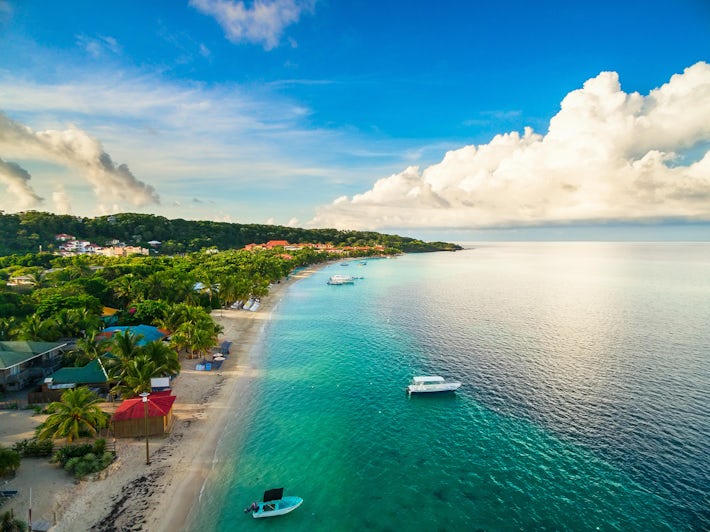
The world's second-longest barrier reef, which starts in Mexico's northern Yucatan, continues offshore along Honduras' Bay Islands and makes for some of the best diving in the Caribbean. Most dive sites ring the southwest tip of Roatan; the most famous is Mary's Place, known for a deep fissure in the coral, which extends to 95 feet.
One of the best snorkel spots on the island is right off West Bay Beach, by far the island's nicest stretch of sand. Walk past the restaurants and resorts to the far end of the beach to find an expanse of coral reef.
It’s not common to see sharks, but you’ll get the chance to have many other marine life encounters, including small fishes such as parrotfish, jacks and butterflyfish. Occasionally, sea turtles may also make an appearance.
6. Cayman Islands: Visit the USS Kittiwake off the Coast of Grand Cayman and Swing with Stingrays at Stingray City

Grand Cayman is another storied dive destination that won't disappoint. Though it's best known for wall diving, one of the most popular sites is the USS Kittiwake, which served from 1945 to 1994; her most memorable mission was the recovery of the Challenger space shuttle disaster.
Scuttled in January of 2011, corals are slowly taking hold on the ship's five decks. You’ll also see plenty of sponges, goliath groupers and small reef fish like jacks and squirrelfish.
The top of the ship is in only 15 feet of water, making it suitable for snorkelers, but the signature snorkel experience on the island is at the famed Stingray City and Sandbar. It draws the crowds, so if you can go early in the morning, by all means do.
Best Snorkeling and Diving in the Eastern Caribbean
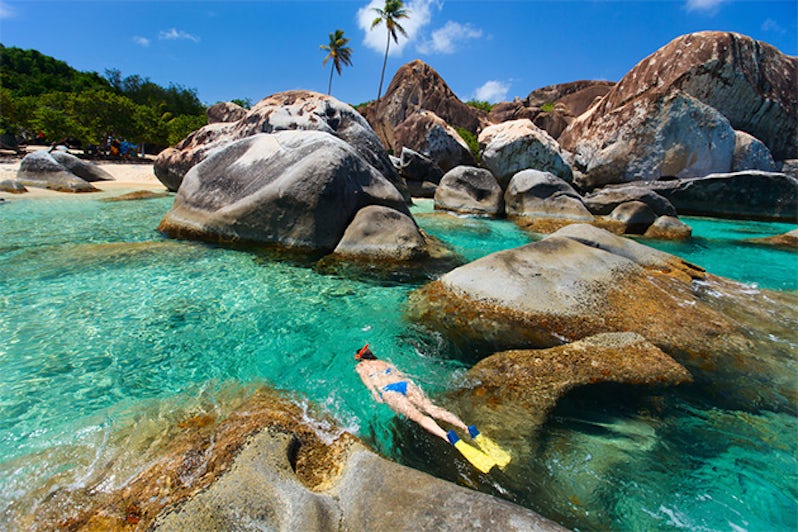
The Eastern Caribbean provides variety for divers and snorkelers, from Florida's underwater state park in Key Largo to some signature wrecks like the RMS Rhone in the British Virgin Islands.
The mostly shallow shorelines of the islands listed here make Eastern Caribbean cruises perfect itineraries for those looking to experience some of the best diving in the Caribbean.
7. The Bahamas: Rose Island Reef, Andros Barrier Reef, Lost Blue Hole and So Much More
There are more than 700 islands in The Bahamas, and the island chain is a veritable buffet for scuba divers.
For day excursions, you'll most likely be confined to Nassau or on Grand Bahama near Freeport, where the ships dock, but never fear: There's plenty of underwater action to be had. Just a quick boat ride from the Nassau cruise terminal, the shallow Rose Island Reef is home to barracudas, green turtles, stingrays and smaller tropical fish.
If you are on a short itinerary exclusively in the Bahamas, you may be able to fly to Andros Island. The stunning Andros Barrier Reef has a drop of some 6,000 feet in the Tongue of the Ocean side of it. Deep water sponges, marlins, stingrays and red snapper are only some of the creatures you’ll see.
Open water-certified divers are allowed to go to the famous Lost Blue Hole, which is about 200 feet deep. Visibility is excellent year-round at 72-78 feet, and you can expect to see sponges, turtles and reef fish.
8. Grand Turk: Dive in the (Outdoor) Aquarium and Snorkel in the Columbus Landfall National Park
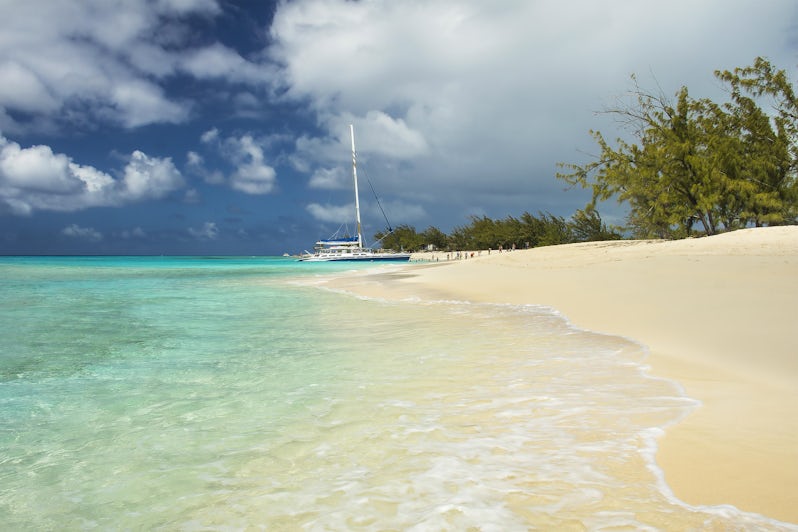
Tiny Grand Turk in the Turks and Caicos is a gem for divers. Do yourself a favor and hightail it from the cruise port to Cockburn Town, where you'll find a number of dive shops strung along an oceanfront street. Just a few hundred yards from shore, the crystal-blue water gives way to inky cobalt where the wall drops away to 7,000 feet.
Most dives are on the west side of the island, with the reef starting in just 30 feet of water. Visibility averages 100 feet at sites like The Aquarium, where the reef rises and falls to create several sand canyons. Although some of the coral has been affected by the Stony Coral Tissue Loss Disease (SCTLD), you can still see healthy brain coral, boulder star coral and sponges.
Visiting snorkelers will want to join an excursion to Columbus Landfall National Park, a protected marine sanctuary running along the entire western side of the island. For the best snorkeling in this Caribbean island, head to Pillory Beach, where you'll likely see nurse sharks, conchs and small tropicals.
9. La Romana, Dominican Republic: La Romana Is Just the Beginning
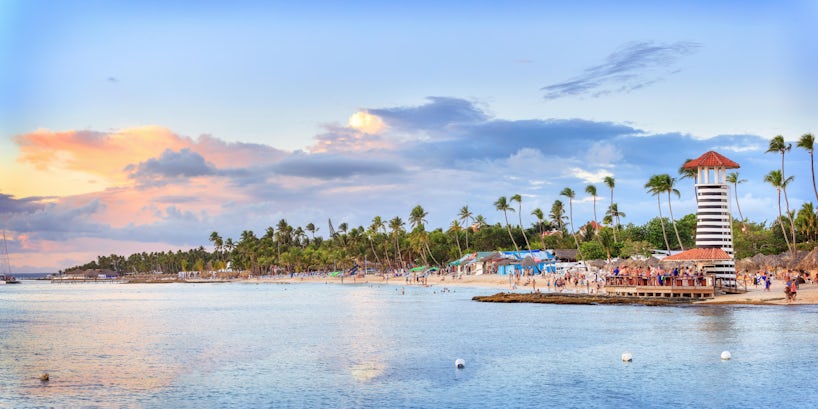
The eastern region of the Dominican Republic, home to both La Romana and Samana, offers tons of scuba options. The once sleepy fishing village of Bayahibe, about 30 minutes from La Romana, is the launching pad for many of the island's best dives.
At El Penon, you'll find a reef ledge overrun with life, from green morays and nurse sharks to giant crabs. The wreck of the St. George offers exploration of the wheelhouse and hallways.
Snorkelers will want to check out the coral around Saona Island, part of the protected Parque Nacional del Este.
10. Virgin Gorda, British Virgin Islands: Snorkel in the Must-Try The Baths and Swim Through Various Wrecks
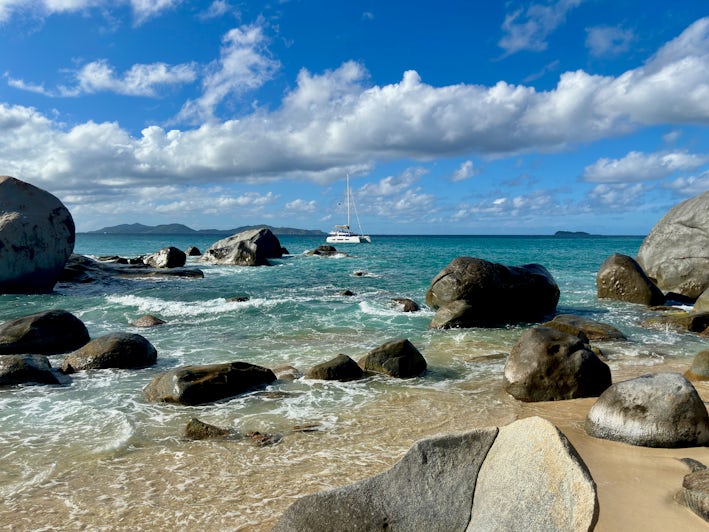
The BVIs are not only a playground for sailboats, but for divers and snorkelers. The granite boulders of The Baths on Virgin Gorda are a must-snorkel, even for the hardest of hard-core divers.
After that, take your pick of wrecks like the famous RMS Rhone, a royal mail steamer that went down with 123 passengers in 1867 -- the BVIs' signature dive and shallow enough to be enjoyed by snorkelers.
The Chikuzen, a 246-foot-long refrigeration ship lying between Virgin Gorda and Anegada is also worth a few tanks; it attracts sharks, cubera snappers and a resident 600-pound goliath grouper. For advanced divers only.
Intermediate divers will want to take a look at Spyglass Wall, which features lots of sea fans and small fish, such as damselfish, wrasse and fairy basslets. Keep a lookout for southern stingrays and passing tarpon.
11. St. Thomas and St. Croix, U.S. Virgin Islands: Check Out the WIT Shoal II or the Frederiksted Pier if You're an Advanced Diver
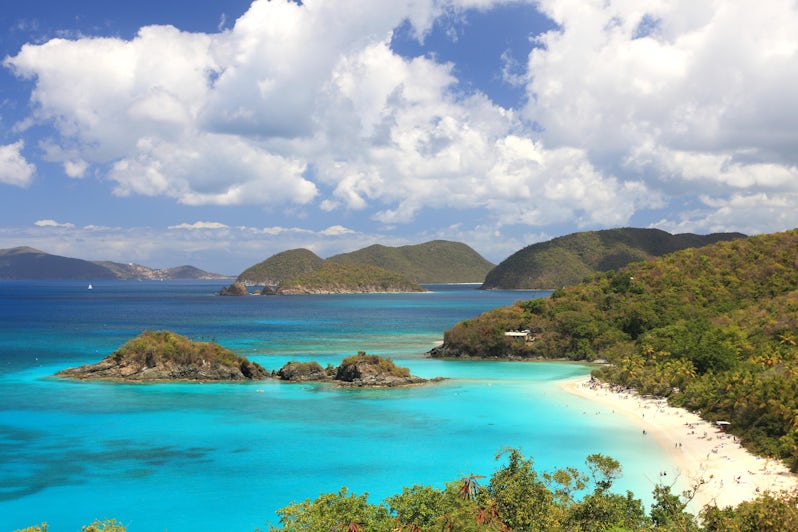
St. Thomas is one of the Caribbean's most popular cruise ship ports, but it's also a good jumping-off point for some great underwater sightseeing, especially for experienced divers.
The waters around St. Thomas are littered with wrecks; the most requested is WIT Shoal II. Originally a warship, it sank in 1984 a few miles southwest of the St. Thomas airport. There are five levels of decks to explore, and the ship is home to horse-eye jacks, stingrays, lobster, crabs, cup coral and sponges. The ship sits in 85 to 90 feet of water, though, so it's best for advanced divers.
Don’t fret if you want to stay closer to the beach; there is also great snorkeling and exciting swims with sea turtles near the reefs.
Of all the U.S. Virgin Islands, St. Croix is the most well-known to divers. You'll be spoiled for choice with wrecks, reefs, walls and a fantastic macro dive at the Frederiksted Pier (a terrific night dive, if possible). Scattered debris under the pier provides habitat for a number of sea animals, from juvenile drums and smooth trunkfish to seahorses.
Located on the West End of the island, Butler Bay holds a number of wrecks. Cane Bay, in the north, is renowned as one of the finest shore dives in the Caribbean; swim out and you'll find the awesome wall, which plummets to 3,000 feet. It's home to soft coral, sponges and gorgonian sea fans.
12. St. Kitts: Wrecks, Reefs, Walls, Caves and Monkey Shoals
Dive itineraries in St. Kitts often include the M.V. River Taw, a 144-foot freighter that sits in about 50 feet of water. It was intact until 1989, when Hurricane Hugo broke it in two pieces, but it's still a good spot to see plentiful fish.
There are wrecks, reefs, walls and caves, too. At the Black Coral Reef site, divers can check out the eponymous black coral abundant at the site, as well as creole wrasse and snapper schooling along the wall's edge. At Monkey Shoals, a large coral atoll, flying gurnards and scorpionfish are frequently sighted, depending on the current.
White House Bay offers sheltered waters for snorkeling. While the beach is pebbly, the rocky bottom provides plenty of hiding places for fish. Keep an eye out for the buoy that marks a shallow shipwreck.
Best Snorkeling and Diving in the Southern Caribbean
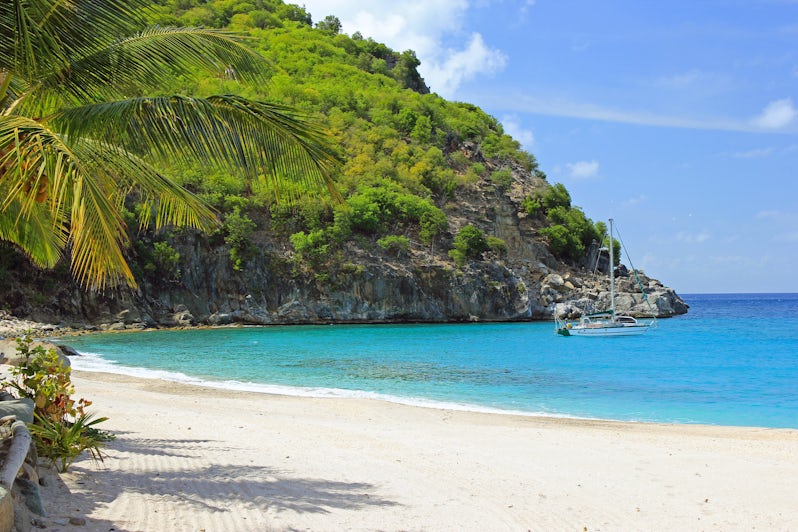
Between wrecks and reefs, pinnacles and pelagics, the Southern Caribbean offers some of the region's best opportunities for diving and snorkeling. Undersea adventures are easy to arrange on Southern Caribbean cruises that call on these islands, and many dive shops offer beginner courses.
13. Bonaire: Top-Tier Shore Diving in a Marine Preserve and off the Coast of an Uninhabited Island
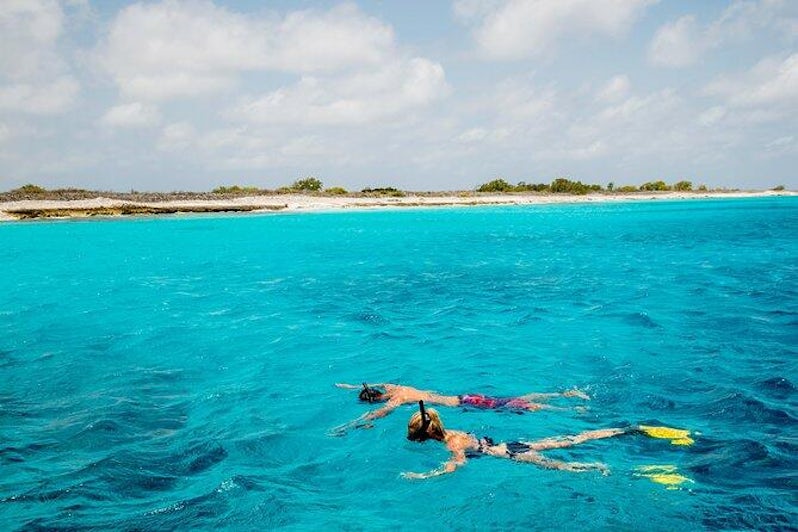
Bonaire is considered one of the world’s top spots for shore diving. The island is renowned for its macro-life and visibility that can extend to 200 feet below the surface. A marine preserve was established in 1979, protecting all of the island's shoreline, from the high-water mark out to 200 feet deep.
There are dozens of great sites for all skill levels and interests, most within a short drive or boat ride of the cruise port. Follow the yellow-painted stones planted next to the road to get to any of them.
Another 26 sites ring the tiny, uninhabited island of Klein Bonaire, just offshore and accessible by boat. The area is teeming with marine life, including sponges, turtles and barracudas.
Your cruise line will probably offer multiple options, but it’s also easy to plan your own snorkeling or diving trip by contacting the local shops. But be warned, while Bonaire is home to some of the best diving in the Caribbean, don’t expect to encounter bigger sea life.
14. Aruba: 30 Dive Sites, a Barrier Reef and Wrecks on Wrecks
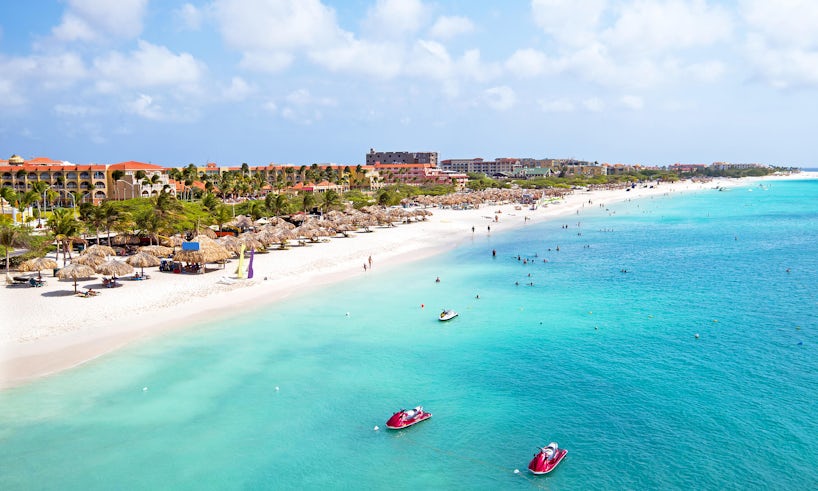
With steady northeast trade winds, Aruba is best known as a windsurfing and kitesurfing destination. But, plan to don your wetsuit here, too, as there are around 30 named dive sites on the island. A barrier reef extends between Oranjestad, where the cruise port is located, and the island's southern tip -- but what Aruba is best known for is its wrecks.
The remains of the German freighter Antilla lie in 60 feet of water and are the island's most popular dive site. Scuttled in Malmok Bay by its crew at the outset of World War II, the 400-foot ship is one of the largest diveable wrecks in the Caribbean, and it's now home to tube sponges, hawksbill turtles, lobsters and plentiful fish life.
Note for snorkelers: The upper decks are easily visible from the surface.
15. Barbados: Gibbs Beach and Wrecks Near Carlisle Bay for All Diving Levels
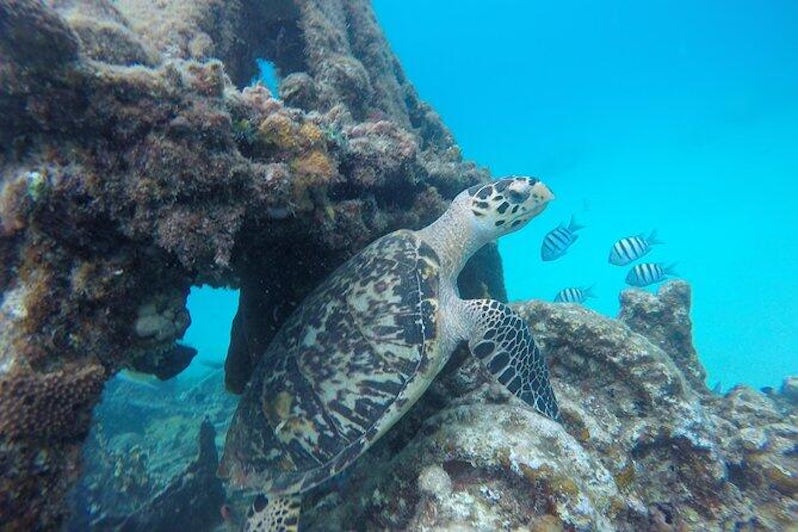
Barbados is, to many, the best Caribbean island for snorkeling. This coral limestone island has beautiful reefs with excellent visibility, affording snorkelers of all abilities excellent chances to see cowfish, rainbow fish and needlefish. Just a 30-minute drive away from the cruise terminal is Gibbs Beach, one of the top spots on the island, with clear waters and lots of marine life.
The island also offers intriguing wrecks perfect for novice and experienced scuba divers. Those around Carlisle Bay marine park are particularly exciting, with a fair amount of relics such as cannonballs and anchors. The area’s six shallow wrecks, with depths ranging from 10 to 45 feet, are all accessible on the same dive.
Snorkelers will also love this bay, as there are tons of things to see in the shallow waters, including manta rays, sea turtles, and some of the ship relics.
16. Curaçao: Curaçao Marine Park, Klein Curaçao and More

The waters around Curaçao deserve exploration. A fringing reef system hugs the shore, so surface swims are short, and most dive sites are in the 60-foot range. This means that even inexperienced divers can log at least 45 minutes of bottom time.
Beginner divers will love the easy, sloping reefs; advanced divers should check out the wreck of the cargo ship, the Superior Producer, which sank in 1977 in 100 feet of water.
Snorkeling is also easily accessed from shore. You'll see plenty of macro-life, such as frogfish, seahorses and mantis shrimp, at sites like Bullenbaai, but keep your eye out for rays and turtles, too.
The Curaçao Marine Park is one of the island’s top spots, stretching over a dozen miles and home to more than 350 fish species. It’s a serene experience where you’ll get a chance to see healthy reefs and coral cliffs. For something a little bit different, take a look at the sunken boat on Tugboat Beach. It’s only about 16 feet deep and covered in coral.
Located just a few miles from Curaçao, Klein Curaçao offers diving and snorkeling spots, as well as pristine beaches and a picturesque pink lighthouse.
17. Grenada: "The Titanic of the Caribbean" for Advanced Divers and Underwater Sculpture Park for Casual Divers and Snorkelers
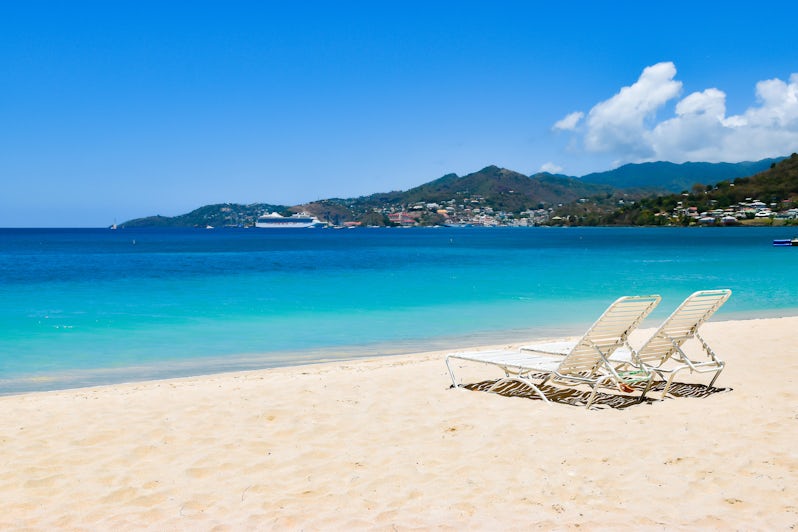
Verdant Grenada offers plenty of variety: drift diving, an underwater museum of statues and one of the Caribbean's most famous wrecks, the Bianca C. Known as "The Titanic of the Caribbean," it is 584 feet long, dwarfing other wreck dives in the region. The wreck sits on a sandbank 165 feet down, so it's only suitable for advanced divers.
For a casual diving or snorkeling experience, check out the Underwater Sculpture Park, much like the one in Cancun. Life-size human statues, like "Vicissitudes," a circle of children, host coral in 15 feet of water.
18. Dominica: Scotts Head Pinnacle and Champagne Reef

Dominica is one of the Caribbean's diving gems, and if you're lucky enough to dock here, you'll know why. The mountainous volcanic island offers plunging walls, bubbling sea vents, reefs, corals and a year-round pod of sperm whales.
Scotts Head Pinnacle in Soufriere-Scotts Head Marine Reserve is one of the island's most popular dives and begins with a swim-through that puts you face-to-regulator with soldierfish, grunts and lobster.
As for snorkeling, the Champagne Reef is a must, where you can swim through bubble streams created by volcanic vents on the seafloor.
19. Martinique: Precheur-St. Pierre, Anses d'Arlet, Diamond Rock and More
The French territory of Martinique's diving is concentrated around three areas. Below the dormant summit of the infamous Mount Pelee volcano, Precheur-St. Pierre offers walls, wrecks and black sand.
To the south, Anses d'Arlet is a white-sand seabed, with a mix of rocky slopes and walls. Just down the coast, Baie du Diamant offers some nice coral and great snorkeling opportunities.
Offshore Baie du Diamant on the southern coast lies the outcrop known as Diamond Rock, home of the French island's most famous dive site. The rock can present challenging diving conditions (watch for current), but there is a spectacular cavern extending from one end of the island to the other -- not for the novice nor faint of heart.